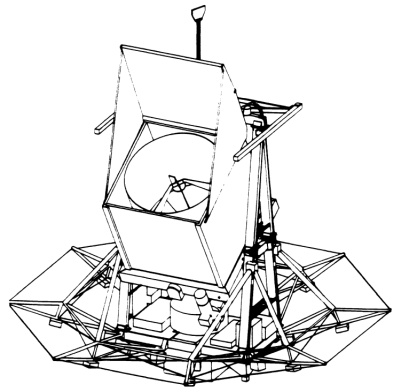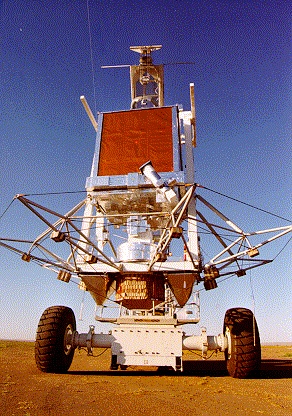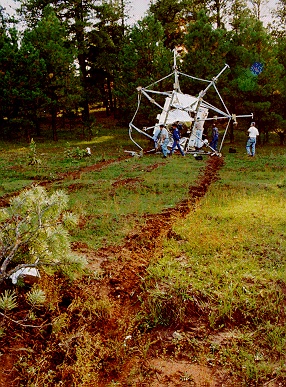Purpose of the flight and payload description
PRONAOS, acronym for "PROgramme NAtional d'Observation Submillimétrique" was a French balloon-borne sub-millimeter telescope designed to observe the cold radiation of the Universe, developed and operated from 1986 to 1999 by the French space agency CNES and several other laboratories. It has been a precursor for several European space missions like FIRST and Planck-Surveyor and the PILOT balloon experiment.
The heart of the instrument was a light-weight telescope of Cassegrian type manufactured by Matra Marconi Space composed by a 2 meters diameter primary mirror formed by six identical panels made in carbon fiber and covered by a gold coating. Its shape was actively controlled during the observations with micrometric sensors and actuators driven by an on-board computer. This system was able to compensate the deformations induced by gravity and temperature effects.
Two different instruments were installed alternativelly at the focus of the telescope in each flight: the SPM (Système de Photométrie Multibande) and the SMH (Spectromètre Hétérodyne).
The SPM detector (for Multiband Photometry System) included four high sensitivity bolometers cooled to a temperature of 0.3 K by a 3He fridge inside a liquid 4He cryostat. The astronomical signal was detected in four different wavelengths bands at 200, 260, 360 and 580 microns. The selection of the wavelength bands was done with dichroic filters so that the four bands monitored the same sky direction.
The SMH (for Heterodyne Spectrometer) was a coherent detection instrument, built around SIS junctions, which performed a simultaneous observation of two lines of emission: H2O at 380.197 GHz and O2 at 368.499 GHz. The development of the instrument was responsability of the Paris Observatory, Meudon.
The telescope and detectors were mounted in a gondola which measured 6.50 meters high by 4 meters wide and weighed 2.8 tons. It was composed of a load-bearing structure formed by a mechanically welded assembly of non-magnetic alloy beams, and a "landing gear" known as SYSPA (système de protection à l'atterrissage) a sort of upside down umbrella intended to prevent the instrument from overturning. The system was completed with cardboard crushable shock absorbers located in the bottom of the assembly. The gondola provided pointing to the telescope using a two-stage system. The first one ensured the azimuthal stabilization within a relative precision of 30 arcseconds, thanks to a magnetometer and a gimbal servoed with gyrometers and inertial wheels. The fine pointing was obtained with an inertial platform which drifts were corrected thanks to the pointing of a star-tracker sensor that could be oriented off-axis from the telescope. As the star-tracker worked at near infrared wavelengths, it was suitable to operate both during night and day time. The telescope pointing precision was of the order of 5 arc-seconds.
The PRONAOS telemetry/telecommand system -developed by the Balloons division of CNES- used an asynchronous serial 8-bit transmission system, which allowed multiple logical channels to be multiplexed into a single physical channel. Three remote control channels (gondola, payload and balloon) were available as well four telemetry channels (two for the gondola, and one each for the payload and balloon).
All onboard subsystems and actuators were powered by a set of lithium batteries that delivered different voltages to each segment with a total capacity of 30 kWh.
Details of the balloon flight

Balloon launched on: 9/17/1994 at 8:15 local
Launch site: Scientific Flight Balloon Facility, Fort Sumner, (NM), US
Balloon launched by: National Scientific Balloon Facility (NSBF)
Balloon manufacturer/size/composition: Zero Pressure Balloon SF3-424.37-080-NSCHR-X-ST
Balloon serial number: W29.47-2X-11
Flight identification number: 387N
End of flight (L for landing time, W for last contact, otherwise termination time): 9/18/1994 at 20:15 utc
Balloon flight duration (F: time at float only, otherwise total flight time in d:days / h:hours or m:minutes - ): 32 h
Landing site: 25 miles SE of Gallup, New Mexico, US
External references
- PRONAOS project web site CNES (no longer active access via archive.org)
- Radio and infrared instruments in the submillimeter astronomy project PRONAOS J. Opt. 21 141 (1990)
- Some Properties of the Spectral Emissivity of the Dust in the Submillimeter/Millimeter Cosmic Dust - Near and Far ASP Conference Series, Vol. 414, proceedings of a conference held 8-12 September 2008 in Heidelberg, Germany
624If you consider this website interesting or useful, you can help me to keep it up and running with a small donation to cover the operational costs. Just the equivalent of the price of a cup of coffee helps a lot.







